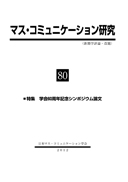80 巻
選択された号の論文の24件中1~24を表示しています
- |<
- <
- 1
- >
- >|
■特集 学会60周年記念シンポジウム論文
-
原稿種別: 本文
2012 年80 巻 p. 2-4
発行日: 2012/01/31
公開日: 2017/10/06
PDF形式でダウンロード (1051K) -
原稿種別: 本文
2012 年80 巻 p. 5-17
発行日: 2012/01/31
公開日: 2017/10/06
PDF形式でダウンロード (1197K) -
原稿種別: 本文
2012 年80 巻 p. 19-35
発行日: 2012/01/31
公開日: 2017/10/06
PDF形式でダウンロード (1215K) -
原稿種別: 本文
2012 年80 巻 p. 37-56
発行日: 2012/01/31
公開日: 2017/10/06
PDF形式でダウンロード (1236K) -
原稿種別: 本文
2012 年80 巻 p. 57-73
発行日: 2012/01/31
公開日: 2017/10/06
PDF形式でダウンロード (1219K) -
原稿種別: 本文
2012 年80 巻 p. 75-94
発行日: 2012/01/31
公開日: 2017/10/06
PDF形式でダウンロード (1239K) -
原稿種別: 本文
2012 年80 巻 p. 95-110
発行日: 2012/01/31
公開日: 2017/10/06
PDF形式でダウンロード (1219K)
■論文
-
原稿種別: 本文
2012 年80 巻 p. 113-132
発行日: 2012/01/31
公開日: 2017/10/06
PDF形式でダウンロード (1337K) -
原稿種別: 本文
2012 年80 巻 p. 133-152
発行日: 2012/01/31
公開日: 2017/10/06
PDF形式でダウンロード (1223K) -
原稿種別: 本文
2012 年80 巻 p. 153-170
発行日: 2012/01/31
公開日: 2017/10/06
PDF形式でダウンロード (1854K) -
原稿種別: 本文
2012 年80 巻 p. 171-189
発行日: 2012/01/31
公開日: 2017/10/06
PDF形式でダウンロード (1248K) -
原稿種別: 本文
2012 年80 巻 p. 191-209
発行日: 2012/01/31
公開日: 2017/10/06
PDF形式でダウンロード (1214K) -
原稿種別: 本文
2012 年80 巻 p. 211-229
発行日: 2012/01/31
公開日: 2017/10/06
PDF形式でダウンロード (1223K) -
原稿種別: 本文
2012 年80 巻 p. 231-248
発行日: 2012/01/31
公開日: 2017/10/06
PDF形式でダウンロード (1250K) -
原稿種別: 本文
2012 年80 巻 p. 249-267
発行日: 2012/01/31
公開日: 2017/10/06
PDF形式でダウンロード (1229K)
■2010年度春季研究発表会 シンポジウム
-
原稿種別: 本文
2012 年80 巻 p. 269-270
発行日: 2012/01/31
公開日: 2017/10/06
PDF形式でダウンロード (1112K) -
原稿種別: 本文
2012 年80 巻 p. 271-272
発行日: 2012/01/31
公開日: 2017/10/06
PDF形式でダウンロード (1111K)
■2011年度春季研究発表会 ワークショップ報告
-
原稿種別: 本文
2012 年80 巻 p. 273-274
発行日: 2012/01/31
公開日: 2017/10/06
PDF形式でダウンロード (1166K) -
原稿種別: 本文
2012 年80 巻 p. 275-276
発行日: 2012/01/31
公開日: 2017/10/06
PDF形式でダウンロード (1112K) -
原稿種別: 本文
2012 年80 巻 p. 277-279
発行日: 2012/01/31
公開日: 2017/10/06
PDF形式でダウンロード (1114K) -
原稿種別: 本文
2012 年80 巻 p. 280-282
発行日: 2012/01/31
公開日: 2017/10/06
PDF形式でダウンロード (1113K) -
原稿種別: 本文
2012 年80 巻 p. 283-284
発行日: 2012/01/31
公開日: 2017/10/06
PDF形式でダウンロード (1113K) -
原稿種別: 本文
2012 年80 巻 p. 285-286
発行日: 2012/01/31
公開日: 2017/10/06
PDF形式でダウンロード (1112K)
■研究会の記録(2011年6月~2011年12月)
-
原稿種別: 本文
2012 年80 巻 p. 287-288
発行日: 2012/01/31
公開日: 2017/10/06
PDF形式でダウンロード (1111K)
- |<
- <
- 1
- >
- >|
